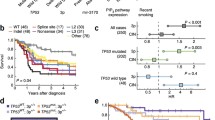Abstract
The objectives of this study are to uncover the molecular mechanisms involved in head and neck squamous cell carcinoma (HNSCC) pathogenesis by studying the chromosomal aberrations in both premalignant and malignant patients and to highlight the genotype of HNSCC in Upper Egypt. From March 2001 to December 2003, prospective study was conducted in 41 patients with precancerous, 79 patients with cancerous laryngeal, oesophageal, nasopharyngeal, nasal, and oral lesions and 50 controls in ENT department, Sohag Faculty of Medicine, Sohag, Egypt. Samples taken by punch biopsy were frozen and stored at −80°C and were subjected to histopathological examination. Metaphase cells were digitally imaged and karyotyped. Karyotypes have been analysed via anatomical image capture and compared with standard human chromosome ideograms. In precancerous lesions, there were 41% 3p loss, 51% 3q gain, 29% 8q gain, and 22% 11q13 gain. In malignant lesions, there were 63% 3p13–p24 loss, 59.5% 5q12–23 loss, 49.5% 8p22–p23 loss, 45.5% 9p21–p24 loss, 40.5% 18q22–q23 loss, 66% 3q gain, 39% 8q gain, and 16% 11q13 gain. In conclusion, early diagnosis of HNSCC can be achieved by DNA extraction from suspicious lesions in high-risk groups (smokers and alcoholics) and examination of chromosomal aberrations of 3p, 3q, 8q, and 11q13. If there are high percent of chromosomal aberrations in these chromosomes, active intervention should be done (chemoprevention and regular follow-up of head and neck examination for very early detection and management).




Similar content being viewed by others
References
Parkin DM, Loara E, Muir CS (1988) Estimates of the world wide frequency of sixteen major cancers in 1980. Int J Cancer 41:184–197
Brennan JA, Sidransky D (1996) Molecular staging of head and neck squamous carcinoma. Cancer Metastasis Rev 15(1):3–10
Heo DS, Snyderman C, Gollin SM, Pan S, Walker E, Deka R, Barnes EL, Johnson JT, Herberman RB, Whiteside TL (1989) Biology, cytogenetics, and sensitivity to immunological effector cells of new head and neck squamous cell carcinoma lines. Cancer Res 49(18):5167–5175
De Braekeleer M, Keushnig M, Lin CC (1986) A high-resolution C-banding technique. Can J Genet Cytol 28(2):317–322
Sumner AT (1972) A simple technique for demonstrating centromeric heterochromatin. Exp Cell Res 75(1):304–306
Mao L, Lee J, Fan YH, Ro JY, Batsakis JG, Lippman S, Hittelman W, Hong WK (1996) Frequent microsatellite alterations at chromosomes 9p21 and 3p14 in oral premalignant lesions and their value in cancer risk assessment. Nat Med 2:682–685
Rosin MP, Cheng X, Poh C, Lam WL, Huang Y, Lovas J, Berean K, Epstein JB, Priddy R Le ND, Zhang L (2000) Use of allelic loss to predict malignant risk for low-grade oral epithelial dysplasia. Clin Cancer Res 6:357–362
Khuri FR, Kim ES, Lee JJ, Winn RJ, Benner SE, Lippman SM, Fu KK, Cooper JS, Vokes EE, Chamberlain RM, Williams B, Pajak TF, Goepfert H, Hong WK (2001) The impact of smoking status, disease stage, and index tumor site on second primary tumor incidence and tumor recurrence in the head and neck retinoid chemoprevention trial. Cancer Epidemiol Biomarkers Prev 10(8):823–829
Ell SR, Ashman JE, Stafford ND, Greenman J (2002) Global genetic differences in squamous cell carcinoma of the head and neck. Laryngoscope 112(6):1094–1099
el-Naggar AK, Lee MS, Wang G, Luna MA, Goepfert H, Batsakis JG (1993) Polymerase chain reaction-based restriction fragment length polymorphism analysis of the short arm of chromosome 3 in primary head and neck squamous carcinoma. Cancer 72(3):881–886
Brzoska PM, Levin NA, Fu KK, Kaplan MJ, Singer MI, Gray JW, Christman MF (1995) Frequent novel DNA copy number increase in squamous cell head and neck tumors. Cancer Res 55(14):3055–3059
Bockmühl U,Wolf G, Schmidt S, Schwendel A, Jahnke V, Dietel M, Petersen I (1998) Genomic alterations associated with malignancy in head and neck cancer. Head Neck 20:145–151
Neel BG, Jhanwar SC, Chaganti RSK, Hayward WS (1982) Two human c-onc genes are located on the long arm of chromosome 8. Proc Natl Acad Sci USA 79:7842–7846
Leonard JH, Kearsley JH, Chenevix-Trench G, Hayward NK (1991) Analysis of gene amplification in head-and-neck squamous-cell carcinoma. Int J Cancer 48:511–515
Spandidos DA, Lamothe A, Field JK (1985) Multiple transcriptional activation of cellular oncogenes in human head and neck solid tumours. Anticancer Res 5:221–224
Sunwoo JB, Sun PC, Gupta VK, Schmidt AP, El-Mofty S, Scholnick SB (1999) Localization of a putative tumor suppressor gene in the sub-telomeric region of chromosome 8p. Oncogene 18(16):2651–2655
van der Riet P, Nawroz H, Hruban RH, Corio R, Tokino K, Koch W, Sidransky D (1994) Frequent loss of chromosome 9p21-22 early in head and neck cancer progression. Cancer Res 54(5):1156–1158
Rowley H, Jones AS, Field JK (1995) Chromosome 18: a possible site for a tumour suppressor gene deletion in squamous cell carcinoma of the head and neck. Clin Otolaryngol 20(3):266–271
Voravud N, Charuruks N, Mutirangura A (1997) Squamous cell carcinoma of head and neck. J Med Assoc Thai 80(4):207–218
Reid CBA, Snow GB, Brakenhoff RH, Braakhuis BJ (1997) Biological implications of genetic changes in head and neck squamous cell carcinogenesis. Aust N Z J Surg 67:410–416
Yoo WJ, Cho SH, Lee YS, Park GS, Kim MS, Kim BK, Park WS, Lee JY, Kang CS (2004) Loss of heterozygosity on chromosomes 3p,8p,9p and 17p in the progression of squamous cell carcinoma of the larynx. J Korean Med Sci 19(3):345–351
Scholnick SB, El-Mofty SK, Shaw ME, Sunwoo JB, Haughey BH, Sun PC, Piccirillo JF, Zequeira MR (1998) Clinical correlations with allelotype in supraglottic squamous cancer. Otolaryngol Head Neck Surg 118(3 Pt 1):363–370
Hermsen M, Guervos MA, Meijer G, Baak J, van Diest P, Marcos CA, Sampedro A (2001) New chromosomal regions with high-level amplifications in squamous cell carcinomas of the larynx and pharynx, identified by comparative genomic hybridization. J Pathol 194(2):177–182
Author information
Authors and Affiliations
Corresponding author
Rights and permissions
About this article
Cite this article
Abou-Elhamd, KE.A., Habib, T.N. The role of chromosomal aberrations in premalignant and malignant lesions in head and neck squamous cell carcinoma. Eur Arch Otorhinolaryngol 265, 203–207 (2008). https://doi.org/10.1007/s00405-007-0420-z
Received:
Accepted:
Published:
Issue Date:
DOI: https://doi.org/10.1007/s00405-007-0420-z




